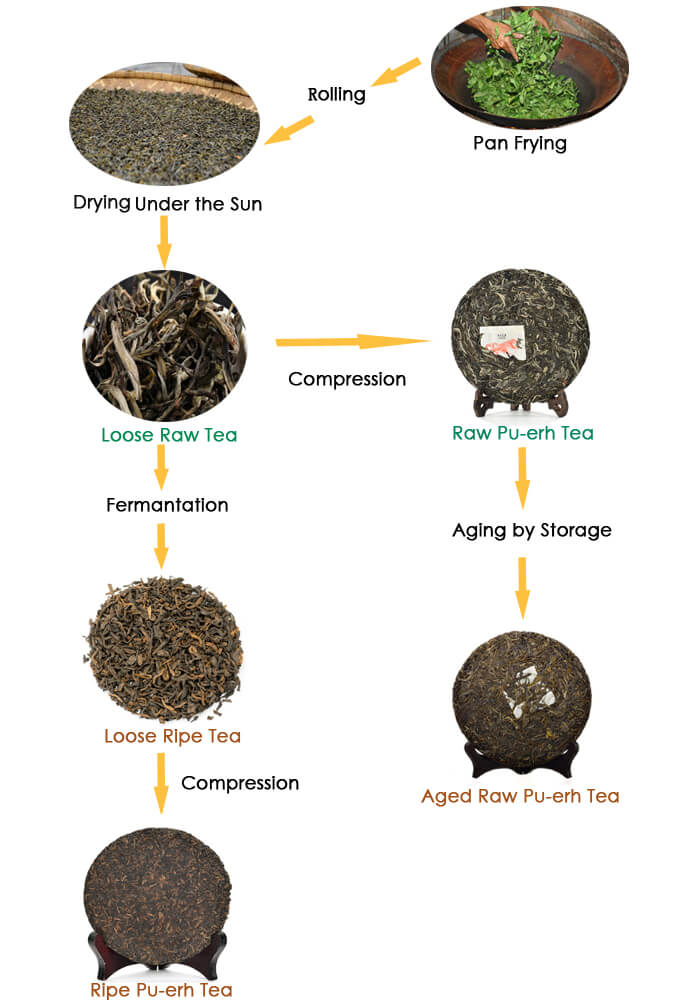Puerh tea 001
Pu’erh tea, also spelled pu-erh or puer, is a type of fermented tea that is native to Yunnan province in China. It is named after the town of Pu’erh, which is located in the southern part of Yunnan province and has a long history of producing and trading tea. The town was a major hub on the ancient Cha Ma Gu Dao (also known as the “Tea Horse Road”) .
Pu’erh Tea Cake and Aging
The method of pressing pu’erh tea into cakes was originally developed as a way to transport the tea over long distances, particularly through the “Tea Horse Road”. The Tea Horse Road was a network of ancient trade routes that stretched across the mountainous regions of Yunnan and Sichuan provinces.
The process of compressing the tea leaves into a cake also helps with the aging and fermentation process, as it allows the tea to mature and develop its unique flavors over time. It also increases the tea’s value as it gets older.
Two Types of Puerh Tea
There are two main types of pu’erh tea with totally different taste: sheng pu’erh (raw/fresh) and shou pu’erh (ripened/cooked).
- Sheng pu’erh is made from raw, unfermented tea leaves and is aged for several years before it is consumed. It is often described as having a complex, fruity flavor and a bright, yellow-green color. Personerly, I am enjoy a dry, bitter initial taste, following a wet, sweet aftertaste.
- Shou pu’erh, on the other hand, is made from fermented tea leaves and has a darker, reddish-brown color and a deep, woody flavor, with a warming, smooth feeling. Shou pu’erh doesn’t make you exciting but calming and relaxing.
 (Image from Raw Puerh vs Cooked Puerh - Tea for Me Please )
(Image from Raw Puerh vs Cooked Puerh - Tea for Me Please )
Both sheng and shou pu’erh cakes can be stored for long periods of time and are often aged for several years before they are consumed.
How to Brew It?
To brew pu’erh tea, you will need the following items:
- Pu’erh tea leaves. You can gently break the cake and take off the tea leaves.
- Filtered water.
- A teapot or a gaiwan (a traditional Chinese lidded bowl used for brewing tea).
- A tea strainer or infuser
Here is a basic recipe for brewing pu’erh tea:
- Bring the water to a boil. And warming up you teapot or gaiwan with hot water.
- Place the tea leaves in the teapot or gaiwan.
- Pour the hot water over the tea leaves. The best ratio of tea to water is 1:20.
- Steep the tea for 15 seconds to 1 minutes, depending on your desired strength.
- Strain the tea into cups or a teapot.
- Repeat step 3, 4 and 5, but keep the infusion short. Good pu’erh is able to steep for 15 times even more!
The first time of doing step 3 and 4, you can rinse tea leaves by pouring a small amount of hot water over them and then discarding the water. This is called “awakening” the tea and is believed to help remove any impurities and enhance the flavors of the tea, being sure to use water that is hot but not boiling, as boiling water can damage the tea leaves and affect the flavor of the tea.
'’Tea drunk warning’’ on sheng pu’erh.
- Sheng pu’erh contains caffeine. If you are sensitive to caffeine, and drink a large amount of pu’erh tea in a short period, you may experience symptoms of caffeine overdose.
- Relatively and personally I prefer drink shou pu’erh after dinner, as it has a comforting, warm, and satisfying flavor that can help to relax and soothe the body and mind. Its bold flavor can also help to cut through rich or heavy foods, making it a good choice for digestion.
How to Storage It?
Proper storage is important for preserving the quality and flavor of pu’erh tea. Here are some tips for storing pu’erh tea:
- Keep the tea away from light and moisture: Pu’erh tea should be stored in a cool, dry, and dark place, away from direct sunlight and sources of moisture. Exposure to light and moisture can cause the tea to lose its flavor and aroma over time.
- Use an airtight container: It is important to store pu’erh tea in an airtight container to keep out any air and moisture that may affect the tea’s quality. Glass or ceramic containers with tight-fitting lids are good options.
- Avoid strong odors: Pu’erh tea can absorb odors from other foods or materials, so it is important to store it away from strong-smelling items.
Hope you enjoy pu’erh tea!